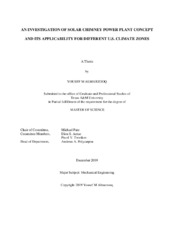| dc.description.abstract | The Solar Chimney Power Plant (SCPP) concept was modeled, analyzed and applied to different locations (climate zones) throughout the U.S. The SCPP system includes three main components, namely the collector, the chimney and the turbine, with the horizontal collector covering a large area at ground level, the vertical chimney located at the center of the collector and the turbine mounted at the bottom of the chimney. The SCPP functions by heating air that gains momentum due to buoyancy forces that in turn rotate turbine blades producing mechanical work. As a result, the SCPP concept works under two basic principles, namely the greenhouse effect, and as noted above, the chimney effect. With regards to the greenhouse effect, the air enters the collector where it is heated by the sun’s rays that strike the horizontal collector surface, which has a glazing cover that admits short-wave radiation while keeping the long-wave radiation emitted from the heated ground inside the collector.
A CFD model was formulated to investigate the behavior and performance of the SCPP concept with a particular focus on determining the maximum air velocity as a function of environmental conditions, namely incident solar radiation and outdoor ambient temperature. The power output from the SCPP was modeled analytically by using energy equations and heat transfer relationships that included solar radiation along with velocity inputs from the CFD model. The analytical model output was then used to develop a prediction model, based on a polynomial equation, for calculating generated power as a function of the Global Horizontal Irradiance (GHI) and the ambient temperature (T∞) with both being dependent on geographical location and time of the year. To aid the application of the power prediction model to the real world, two more models, consisting of polynomial equations, were developed for calculating the GHI and T∞ for different U.S climate zones and for varying times of the year. Afterwards, the annual power output for each climate zone was found, which will provide guidance for those that are considering the use of a SCPP system as an alternative to fossil fuel power plants. | en |


